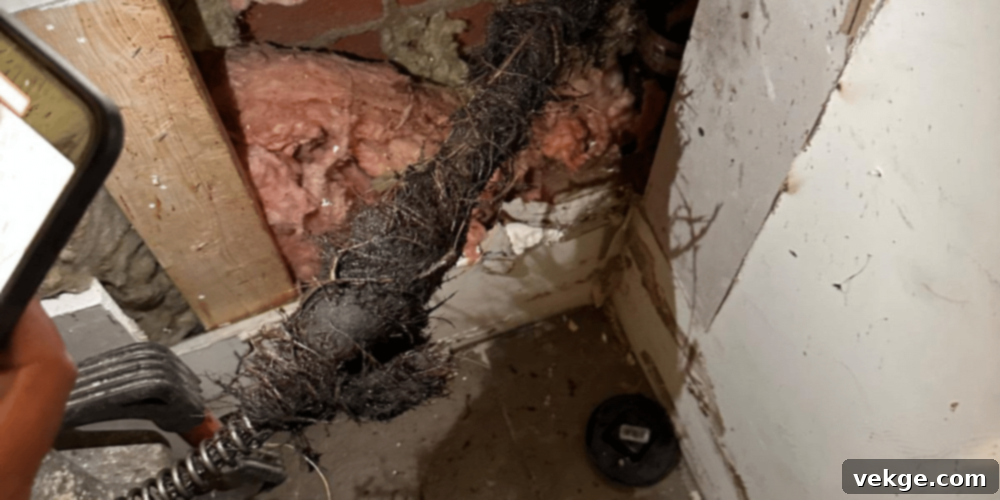Your Essential Home Guide: Mastering Common Plumbing & HVAC Issues and Solutions
Welcome, homeowner! Maintaining a comfortable and functional living space often means understanding and addressing a variety of household issues, especially those concerning your plumbing and HVAC systems. While these systems work tirelessly behind the scenes, problems can arise, causing inconvenience and potential damage. But don’t fret! This comprehensive guide is designed to empower you with the knowledge to identify, understand, and effectively tackle some of the most common plumbing and heating challenges you might encounter. From stubborn drain blockages to crucial furnace maintenance and safe gas appliance installations, we’re here to simplify complex issues and provide clear, actionable solutions. Let’s dive in and ensure your home runs smoothly all year round!
Understanding and Resolving Drain Backups and Blocked Drains
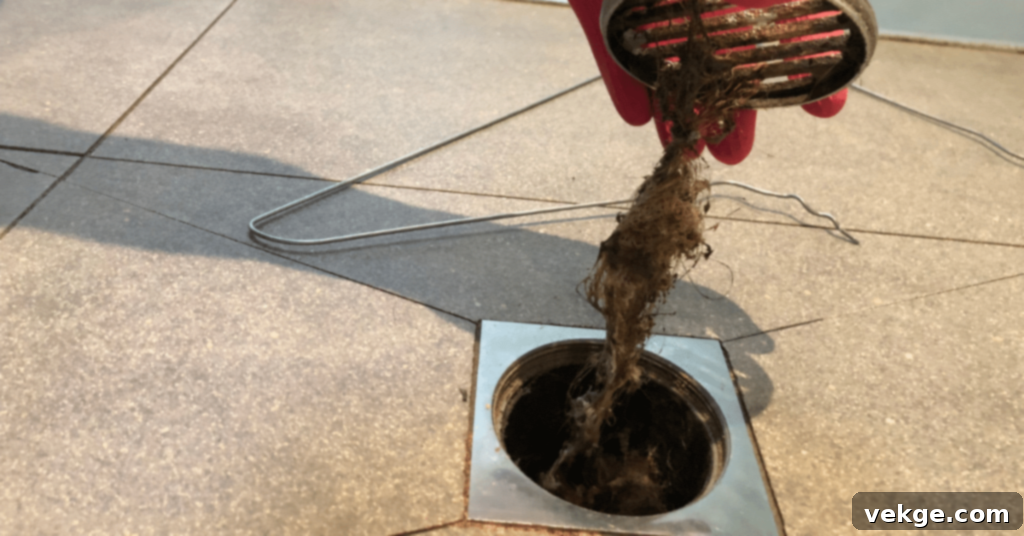
Few things are as frustrating as a slow-draining sink or a backed-up toilet. Drain backups and blocked drains are among the most common plumbing nuisances, often signaling a blockage within your drain lines. These obstructions can be caused by an accumulation of everyday household waste, including hair, grease, soap scum, food particles, and even foreign objects that mistakenly find their way into the pipes. In some cases, more severe blockages can be attributed to tree roots infiltrating the pipes, especially in older plumbing systems, leading to persistent and recurring issues.
Symptoms to watch for: Besides obvious water backups, keep an eye out for slow drainage, gurgling sounds from drains, or foul odors emanating from your sinks, showers, or tubs. Ignoring these signs can lead to more significant problems, including burst pipes or extensive water damage.
Solution: Advanced Hydro Jetting for Effective Clearing. When conventional plungers or chemical drain cleaners fall short, hydro jetting emerges as a highly effective and environmentally friendly solution. This powerful technique employs a high-pressure stream of water, delivered through a specialized nozzle, to scour the interior walls of your pipes. It’s like a deep, thorough power wash for your plumbing system, capable of breaking down and flushing away stubborn grease, mineral buildup, scale, and even invasive tree roots that have taken hold. Unlike snaking, which often just pokes a hole through the blockage, hydro jetting cleans the entire pipe diameter, significantly reducing the likelihood of future blockages and restoring your drainage system to optimal performance.
Prevention is Key: To minimize the risk of drain blockages, consider using drain screens to catch hair and food particles, avoid pouring grease down the sink, and flush drains regularly with hot water. For persistent issues, contacting a professional for an inspection is always advisable.
Repairing and Replacing Damaged Drain Pipes
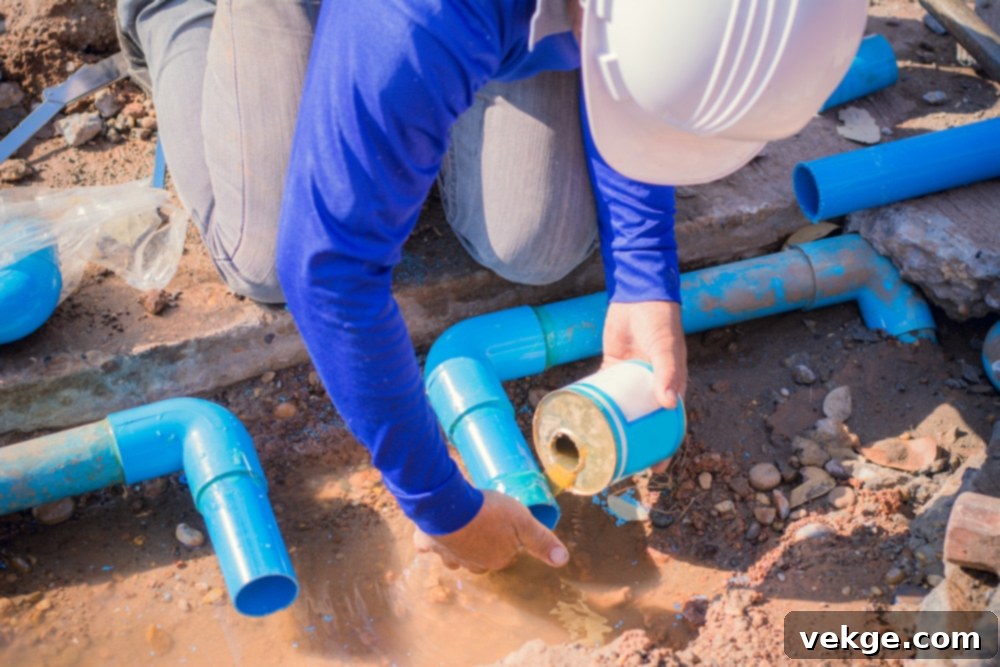
While a simple blockage can often be cleared, recurring drain issues or more severe symptoms might point to a deeper problem: damaged, corroded, or deteriorating drain pipes. Over time, pipes can suffer from wear and tear, shifting ground, extreme temperatures, or invasive tree roots, leading to cracks, leaks, or even collapses. Ignoring these structural issues can result in significant property damage, health hazards from sewage leaks, and costly emergency repairs down the line.
Signs of pipe damage: Beyond frequent backups, be alert for unusual noises (such as gurgling or banging) coming from your pipes, persistent foul odors, unexplained wet spots on your lawn or in your basement, or a sudden increase in your water bill. These indicators suggest that your pipes may be compromised and require immediate attention.
Solution: Expert Diagnosis and Tailored Repair. When faced with suspected pipe damage, professional plumbers utilize advanced diagnostic tools, such as in-pipe camera inspections. These high-resolution cameras provide a real-time, visual assessment of the pipe’s interior, allowing technicians to accurately pinpoint the exact location and nature of the damage without invasive digging. Depending on the severity and type of damage, solutions can range from targeted repairs—like patching a small section using trenchless methods that minimize disruption to your property—to a complete drain replacement. A full replacement might be necessary for severely deteriorated or collapsed pipes, ensuring the long-term integrity and efficiency of your plumbing system. Professional assessment guarantees the right solution is applied for lasting results.
Maintaining and Upgrading Hot Water Heaters and Tanks
A sudden blast of cold water during a morning shower is an unwelcome surprise and a clear sign that your hot water heater might be in distress. Hot water heaters and tanks are crucial for daily comfort, providing hot water for bathing, cleaning, and cooking. When they malfunction, it significantly disrupts household routines. Issues can range from a complete lack of hot water to inconsistent temperatures, strange noises, or even visible leaks.
Common problems: Sediment buildup in the tank, a faulty heating element or thermostat, a leaking pressure relief valve, or corrosion inside the tank can all lead to performance issues. Rusty water coming from your hot tap often indicates internal corrosion and suggests the tank may be nearing the end of its lifespan.
Solution: Proactive Maintenance and Strategic Upgrades. The longevity and efficiency of your water heater heavily depend on consistent maintenance. Regularly flushing the tank is paramount to eliminate sediment accumulation, which can reduce efficiency and lead to premature wear. Professionals can also inspect and test the pressure relief valve for proper function, check the anode rod (a sacrificial component that prevents tank corrosion), and verify the heating elements or burner assembly are operating correctly. If your unit is older (typically 10-15 years) or requires frequent, costly repairs, it might be more economical and beneficial to consider an upgrade. Modern, energy-efficient models, including tankless water heaters, offer significant long-term savings on utility bills, improved performance, and a more consistent supply of hot water, making them a wise investment for any home.
Seamless Faucet Installation for Style and Function
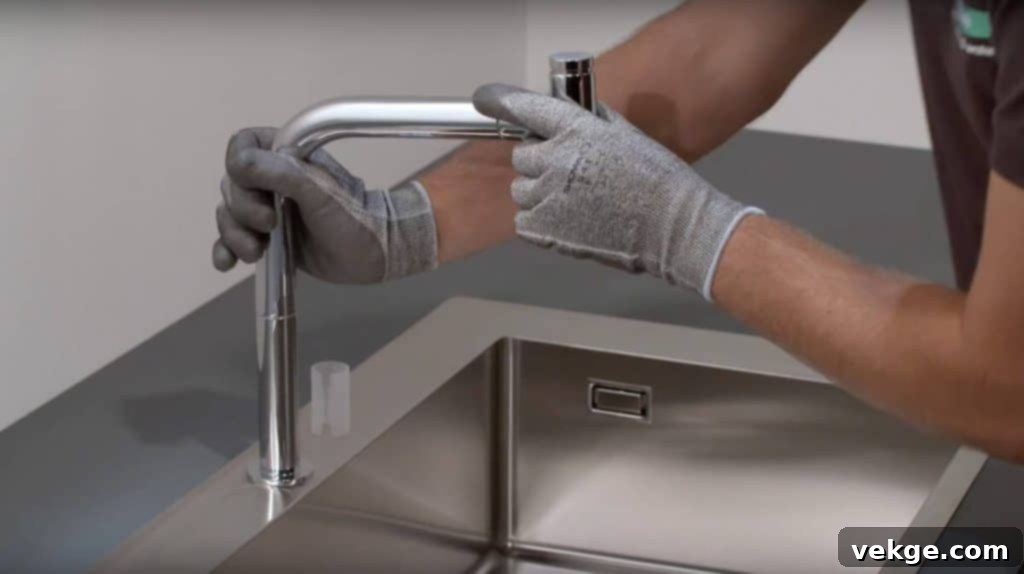
Updating your home’s faucets is a straightforward way to refresh the aesthetic of your kitchen or bathroom while also enhancing functionality. Whether you’re replacing a constantly dripping, leaky faucet that wastes water and money, or simply seeking a new style to complement a renovated space, proper installation is absolutely critical. A poorly installed faucet can lead to persistent leaks, water damage, and ongoing frustration, negating any aesthetic or functional benefits.
Choosing the right faucet: Consider factors like design, finish, features (e.g., pull-down sprayers, touchless technology), and compatibility with your existing sink and plumbing connections. The market offers a vast array of options, from sleek modern designs to classic traditional styles, each with specific installation requirements.
Solution: DIY with Caution or Professional Expertise. For the DIY-savvy homeowner, installing a new faucet can be a rewarding project. Ensure you have the correct tools—such as basin wrenches, plumber’s putty, and adjustable wrenches—and meticulously follow the manufacturer’s instructions. Pay close attention to sealing connections to prevent leaks and ensuring all components are tightened appropriately without overtightening. However, if plumbing isn’t your area of expertise, or if you encounter unexpected challenges like corroded pipes or unusual connections, enlisting the help of a professional plumber is highly recommended. A professional ensures the installation is performed correctly, efficiently, and leak-free, saving you time, preventing potential water damage, and guaranteeing proper functionality for years to come.
Protecting Your Home from Frozen Pipes
For homes in colder climates, winter brings the significant risk of frozen pipes. When water inside pipes freezes, it expands, creating immense pressure that can lead to pipes cracking or bursting. A burst pipe can cause extensive and costly water damage to your home, impacting walls, floors, furniture, and electrical systems, and requiring immediate emergency attention.
Causes and Risks: Exposed pipes in unheated areas like basements, crawl spaces, attics, garages, or exterior walls are particularly vulnerable. Even a slight drop below freezing temperatures can cause issues if pipes are not adequately protected. The damage typically occurs not at the point of freezing, but further down the line where the expanding ice creates a pressure blockage.
Solution: Prevention and Safe Thawing. The best defense against frozen pipes is prevention. Insulate any exposed pipes using pipe sleeves or heat tape, especially in colder parts of your home. During extreme cold snaps, keep your home’s thermostat set to a consistent temperature (even if you’re away) and consider opening cabinet doors under sinks to allow warmer air to circulate around pipes. You can also let a faucet drip slowly to maintain water flow, which helps prevent freezing. If you suspect a pipe is frozen (e.g., no water coming from a faucet during cold weather), thaw it slowly and gently. Use a hairdryer on a low setting, warm towels, or a portable space heater aimed at the affected area. Never use an open flame or high heat source, as this can cause the pipe to burst or create a fire hazard. If a pipe bursts, immediately locate and turn off your main water shut-off valve to minimize water damage, then call a professional plumber for repair.
Essential Furnace Maintenance for Winter Warmth
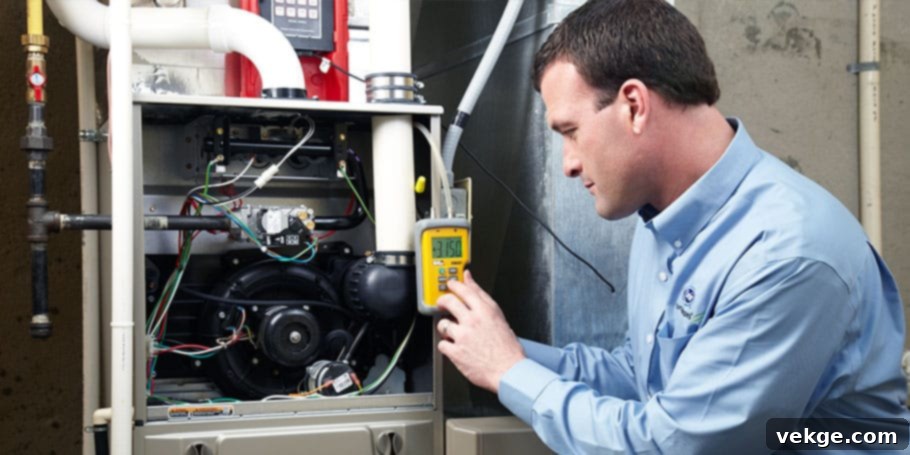
Your furnace is the unsung hero of your home during the colder months, tirelessly working to maintain warmth and comfort. Just like any complex mechanical system, it requires regular attention to ensure it operates efficiently, safely, and reliably. Neglecting furnace maintenance can lead to reduced efficiency, higher energy bills, unexpected breakdowns, and even potential safety hazards like carbon monoxide leaks.
Why annual maintenance matters: Regular furnace maintenance extends the lifespan of your unit, improves its energy efficiency (saving you money), prevents costly emergency repairs, and most importantly, ensures the safety of your home and family by checking for gas leaks and proper ventilation.
Solution: Schedule Annual Professional Check-ups. The most effective way to keep your heating system in prime condition is to schedule annual inspections and tune-ups with a qualified HVAC professional, ideally before the heating season begins. During these visits, technicians will perform a comprehensive series of checks: they will clean and inspect the burners and heat exchanger, replace or clean air filters, lubricate moving parts, check and calibrate the thermostat, inspect the ductwork for leaks, and verify that all safety controls are functioning correctly. They will also test for carbon monoxide leaks, providing crucial peace of mind. This proactive approach helps identify and rectify potential issues before they escalate into major problems, ensuring your home remains warm and safe throughout the winter.
Safe and Expert Gas Appliance Installation
The convenience and efficiency of gas appliances, such as stoves, ovens, dryers, water heaters, fireplaces, and outdoor BBQs, are undeniable. However, their installation requires a high level of expertise due to the inherent safety risks associated with gas lines. Improper installation can lead to dangerous gas leaks, fire hazards, or even carbon monoxide poisoning, making professional installation a non-negotiable requirement.
The dangers of DIY gas work: Attempting to install or connect gas appliances without the proper training, tools, and licensing can have severe consequences. Gas lines involve precise connections, pressure testing, and adherence to strict local building codes and safety regulations that only a certified professional fully understands.
Solution: Always Hire a Licensed Professional. For any gas appliance installation, it is imperative to hire a licensed and experienced gasfitter or plumber. These professionals have the specialized knowledge and certifications required to handle gas lines safely. They will ensure all connections are made securely, test for any leaks using appropriate equipment, verify proper ventilation, and confirm that the appliance is operating according to manufacturer specifications and local safety codes. This expert approach not only guarantees the safety of your home and family but also ensures the appliance operates efficiently and reliably. Always remember to have working carbon monoxide detectors installed near gas appliances for an added layer of safety.
Embracing Cleaner Living with Home Water Filtration
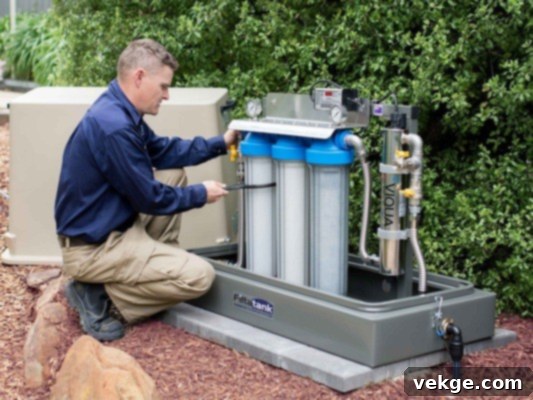
The quality of your drinking water is directly linked to your health and well-being. While municipal water supplies are treated, they can still contain various impurities, contaminants, and chemicals that affect taste, odor, and even long-term health. Setting up a home water filtration system is an excellent way to remove these unwanted substances, guaranteeing a supply of clean, safe, and great-tasting water for all your household needs.
Why filter your water? Water filtration removes chlorine, sediment, heavy metals (like lead), pesticides, bacteria, and other dissolved solids that can impact taste, lead to appliance buildup, and pose health risks. Beyond drinking water, filtered water can improve skin and hair health, and extend the life of your plumbing fixtures and appliances.
Solution: Choosing and Installing the Right System. The market offers a wide range of water filtration systems, each designed to address specific concerns. Options include simple pitcher filters for small volumes, faucet-mounted filters for convenience, under-sink systems for dedicated drinking water, and whole-house filtration systems that treat all water entering your home. To choose the best system, consider having your water tested to identify specific contaminants. Professional installation is highly recommended for under-sink and whole-house systems to ensure proper connections, optimal flow, and effective filtration without leaks. Regular filter replacement, as per manufacturer guidelines, is crucial to maintain the system’s effectiveness and water quality.
Maintaining Your Outdoor Faucets for Year-Round Use
Outdoor faucets, also known as hose bibs or spigots, provide incredible convenience for a multitude of tasks, from watering your garden and washing your car to filling kiddie pools and cleaning outdoor spaces. While seemingly robust, these fixtures require proper maintenance to prevent common issues like leaks and, more critically, damage from freezing temperatures during winter months.
Common issues: Leaks and drips are often caused by worn-out washers or seals, leading to water waste and potentially higher utility bills. However, the most significant threat to outdoor faucets in colder regions is freezing, which can cause pipes to burst inside your walls, leading to substantial water damage once temperatures rise and the ice thaws.
Solution: Regular Checks and Winterization. Regularly inspect your outdoor faucets for any signs of leaks or drips. If you notice a leak, a simple washer replacement can often resolve the issue. More importantly, proper winterization is essential to prevent freezing. Before the first hard freeze, disconnect all hoses from your outdoor faucets. If your outdoor faucet is a non-frost-free type and has an interior shut-off valve, close that valve and open the outdoor faucet to drain any remaining water from the pipe. For all outdoor faucets, especially frost-free models, consider insulating them with a foam cover. This simple preventative measure can save you from the headache and expense of burst pipes and water damage come spring.
Enjoying Safe Gas BBQ and Fireplace Installation
There’s nothing quite like the warmth and ambiance of a gas fireplace on a chilly evening or the joy of cooking outdoors on a convenient gas BBQ. These additions can significantly enhance your home’s comfort and entertainment capabilities. However, just like other gas appliances, their installation demands meticulous attention to safety and adherence to specific codes to prevent hazards.
Why professional installation is crucial: Improperly installed gas lines, incorrect venting (for fireplaces), or inadequate clearances can lead to dangerous gas leaks, carbon monoxide buildup, or fire risks. Unlike propane tanks for portable BBQs, permanent gas BBQs and fireplaces connect directly to your home’s natural gas line, requiring expert handling.
Solution: Entrust to Certified Professionals. For both gas BBQ and fireplace installations, professional assistance is paramount. Licensed plumbers or HVAC technicians specializing in gas line work will ensure that all gas connections are made securely and leak-free, that proper ventilation is established (especially for indoor fireplaces), and that all local building codes and safety regulations are strictly followed. They will also advise on appropriate clearances from combustible materials and conduct necessary tests to confirm safe operation. Investing in professional installation provides peace of mind, guaranteeing your gas appliances are set up correctly and safely for worry-free enjoyment for years to come.
General Plumbing & HVAC Tips for a Well-Maintained Home
Proactive maintenance and prompt attention to minor issues can save you from major plumbing and HVAC headaches and costly repairs down the road. Incorporating these simple habits into your home maintenance routine can significantly extend the life of your systems and ensure continuous comfort.
- Regularly Inspect for Leaks and Drips: Conduct periodic visual inspections of all exposed pipes, faucets, toilets, and appliance connections. Even a small drip can waste significant amounts of water and indicate a developing issue. Check your water meter before and after a period of no water use (e.g., overnight); if the meter reading changes, you likely have a hidden leak.
- Monitor Your Water Pressure: Pay attention to your home’s water pressure. Consistently low pressure can indicate blockages or issues with your main water line, while excessively high pressure can put undue strain on pipes and fixtures, potentially leading to leaks or bursts. A professional plumber can test your pressure and install a regulator if needed.
- Know Your Main Water Shut-Off Valve: This is arguably one of the most critical pieces of plumbing knowledge for any homeowner. In the event of a burst pipe or major leak, knowing how to quickly turn off your home’s main water supply can prevent catastrophic water damage. Practice locating and operating it.
- Schedule Regular Inspections with Professionals: Just as you service your car, your plumbing and HVAC systems benefit from routine professional check-ups. Annual plumbing inspections can catch small issues before they become major emergencies, while furnace and AC tune-ups ensure efficiency, safety, and longevity.
- Be Mindful of What Goes Down Your Drains: Avoid flushing anything other than human waste and toilet paper. In sinks, use drain screens and avoid pouring grease, coffee grounds, or harsh chemicals, which can cause severe blockages and damage pipes.
We hope this comprehensive guide helps you feel more confident in tackling the common plumbing and HVAC challenges you might encounter. Remember, while many minor issues can be addressed with a DIY approach, complex problems, especially those involving gas lines or significant water damage, always warrant the expertise of a licensed professional. Prioritizing regular maintenance and acting quickly on potential issues will keep your home comfortable, safe, and efficient for years to come. Happy plumbing and heating!
